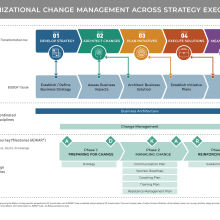As we know, the discipline of business architecture is very much focused on enabling change. Business architecture helps us to inform and translate strategies and other business direction into actionable, coordinated, and business-driven initiatives. Even more importantly, people need to be ready for and actually consume the changes that are planned. Business architecture practitioners are change makers and change leaders, so a solid understanding of organizational change management and how it aligns with business architecture is essential.
In this installment, guest staring Ken Williams, StraightTalk explores the topic of organizational change management and how it works together with business architecture. Ken is uniquely qualified from both a busines architecture and change management perspective and is a Certified Business Architect (CBA)® and a Certified Change Management Professional (CCMP)®. What follows is his enlightening podcast upon which this post was based. Enjoy!
Disclaimer: we’ve made some tiny adjustments for our typical StraightTalk-style: the gray headings represent StraightTalk asking the questions and our guest, Ken, responds in turn. Make sure to check Ken’s fantastic podcast firsthand in 10-Minutes With Ken Williams: How Change Management and Business Architecture Work Together to Help Organizations.
What is organizational change management and how does it help organizations?
Ken: “Whenever we execute strategy and undertake initiatives, it often requires change – changes to the processes, job roles, organizational structure or even the technology we use.
We need to remember that an organization is made up of individuals. So, ultimately it is the individuals that need to change how they do their jobs. If these individuals are unsuccessful in their personal transitions, and if they do not embrace a new way of working, the initiative is going to fail.
We may have brought the initiative in on time and on budget, and delivered on the requirements, but if the individuals do not embrace and adapt to changes required, the initiative will not deliver the expected results.
So, change management is a discipline that helps guide us on how we prepare, equip and support individuals to successfully adopt change in order to drive the organization to success."
When should organizations leverage the discipline of change management?
Ken: “Unfortunately, we typically see an email on Monday and a training on Tuesday with the go live on Wednesday. That’s not change management. Remember we’re trying to prepare, equip and support individuals.
So, we need to start leveraging change management as early as possible – just as we try to leverage business architecture as early as possible.
As we are assessing the business impacts of our initiatives – before we begin to architect the solution – that’s a great place to bring in change management. The impact analysis provides tremendous insight as to the change characteristics. Is it small and incremental? Is it going to be large and disruptive? What’s the scope of the change? Who’s going to be impacted by the change? Equally important, what is the organization’s capacity for change? Is there already too much on the plate? Does the organization have a bad history with change? Are they change resistant? Does the organization have the resources available to adequately support the change?
So, perhaps it is even better is to leverage change management in the very beginning when the business strategy is being defined and when we start to prioritize our objectives. If we can understand the organization’s capacity for change, it can be a tremendous asset to help us with that prioritization.”
How do the disciplines of business architecture and change management relate?
Ken: “I like to think of them as twin sons or daughters of different mothers. They are both about transformation, they are both about senior leader engagement, they are both about consistent communications, and they are both about helping to execute strategy from the business perspective so that we can meet our objectives for the adoption and usage of those stated objectives.”
How would you describe the value of business architecture to a change manager?
Ken: “I would tell him or her that bringing in the business architecture team to help with assessing business impacts is key. All the analysis that business architects do during that phase to identify the impacted value streams, capabilities, business units, etc. is gold for the change management team.
In order to prepare for the change, we need to identify what the key change characteristics are, assess the organization, create our strategy – and so for a change manager, the business architect has done a lot of heavy lifting already.”
What specific business architecture perspectives have you found to be helpful to change management?
Ken: “I would certainly include all of the core business architecture domains: value streams, capabilities, business units and information because they help inform the impacts of change. In addition, stakeholders, initiatives and metrics come in to play as well.
The business architecture knowledgebase as a whole is a great tool to share with change managers to help them understand the aspects of people’s jobs that are changing. Remember, organizational change is made up of individual change and the more that we can share from our knowledgebase about the various domains will help inform the change management strategy.”
Let’s flip the script. Should change management be leveraged when introducing business architecture to an organization?
Ken: “There’s a saying: change management takes change management. I believe the same is true for business architecture. It takes change management.
There are five stages as people go through change: Awareness, Desire, Knowledge, Ability and Reinforcement (ADKAR). So, let’s consider a business architecture stakeholder. We can’t expect them to have an immediate desire to use business architecture without first being aware of the benefits it could bring. Once they have that desire to support business architecture, we can provide them the knowledge or training on how business architecture can support the execution of their strategies. This will provide them with the ability to use that architecture and we can reinforce it through wins.
As you move through ADKAR, you cannot skip a step and expect success. For example, if you offer training, you cannot expect superior results if you have not made the students aware of why they are going through the training so that they can build the desire to be engaged with the training. The same goes for managing business architecture stakeholders. Make sure you know where they are in the process: do they have the desire, do they have the knowledge, do they have the ability and are we reinforcing the change.
In our organization, I have been using change management to build both the change management discipline and the business architecture discipline. So, I am in building change practitioners within the business to be used as needed for specific changes related to their business units. At the same time, I am also building their awareness, desire, and knowledge of business architecture. So, I have essentially cross-trained them.
If you already have a dedicated change management team(s) working in your organization and a business architecture team, then it’s time to unite that family. Bring those twin sons and daughters back together."
Should business architects be educated in change management?
Ken: “It certainly wouldn’t hurt. Business Architecture is about executing strategy successfully. That means change. And change means change management.
You don’t need to be a certified business architect and a certified change management professional like me – though there are certainly people like me who are out there.
It helps to understand the change management methodology, at least at a high-level. The more we understand the other disciplines that we currently interact with and those we want to interact with, the better we can show how business architecture can help support them. And vice versa.”
What are some of the best resources for people to learn about change management?
Ken: “The first book I ever read on change management was called Change Management – The People Side of Change. It’s a great overview on how people change. You can adapt it to not only personal change but also to organizations.
As far as more about the practice of change management, there is the Association of Change Management Professionals (ACMP) and they have a lot of resources on the practice itself. For change management training and other resources, I would recommend Prosci.”
See More Good Stuff for specific links from Ken.
Anything else?
Ken: “Every initiative tells a story and how you tell that story through the business architecture and change management, the better that story will be remembered and adopted.”
Check out the handy diagram below from Ken, which overlays change management onto the strategy execution perspective.
(P.S. See more on the strategy execution perspective referenced in Posts No. 3, No. 50 and No. 72.)
More Good Stuff...
10-Minutes With Ken Williams: How Change Management and Business Architecture Work Together to Help Organizations (StraightTalk podcast): Just in case you missed that link in the beginning, make sure to check out Ken’s enlightening podcast, which was the basis for this post.
Business Architecture and Change Management (Ken Williams): Check out this excellent presentation from Ken, shared last at the Business Architecture Innovation Summit September 2020.
Here are some recommended resources from Ken for further immersion on change management.
- Change Management –The People Side of Change (book by Jeffrey Hiatt and Timothy Creasey): A very good introduction to change management.
- The Association of Change Management Professionals (ACMP) (acmpglobal.org): The professional organization for change management. Make sure to check out the white papers, presentations and webinars. The ACMP also offers a certification program, the Certified Change Management Professional (CCMP). If you would like to take your change management practice a step further, this is a very good certification to obtain.
- Prosci (prosci.com): This organization is recognized as the global leader in change management training, research and webinars. There is a wealth of information available on the practice of change management and the training programs are outstanding.
Creating Sustainable Organizational Culture Change in 80 Days (TED Talk): An interesting TED Talk by Arthur Carmazzi, ranked as one of the world’s Top 10 most influential thought leaders in leadership and organizational culture by Global Gurus. In this talk Arthur briefly covers the foundation of his successful culture transformation methods which have created sustainable organizational culture change in organizations across the world.

